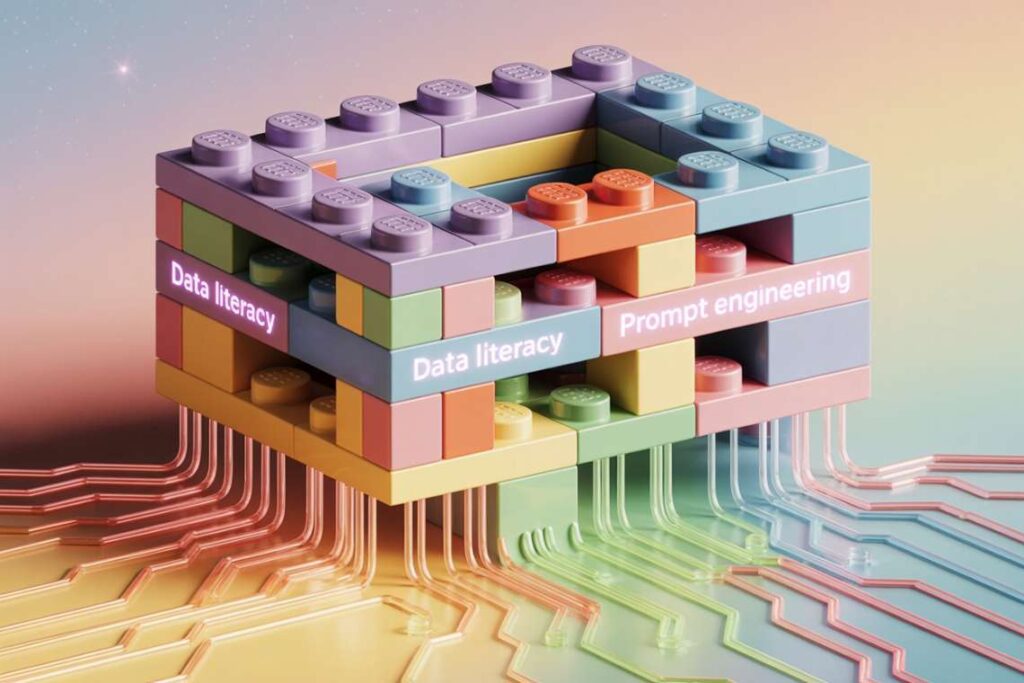Ever feel like the world of Artificial Intelligence is speaking a different language?
You’re bombarded with buzzwords like “machine learning,” “neural networks,” and “deep learning.” There are countless courses, tools, and “expert” opinions, all claiming to hold the key.
If you’re a beginner, especially someone looking to switch careers or simply understand this transformative technology, it’s easy to feel overwhelmed and unsure where to even start.
You might be asking:
- “Is AI too technical for me if I don't have a coding background?”
- “How can I learn AI without wasting precious time and money on the wrong things?”
- “What are the actual foundational AI skills I need?”
What if I told you there's a smarter, more manageable way to learn AI?
A method that cuts through the noise, builds your confidence step-by-step, and makes the journey feel purposeful, not paralyzing?
Welcome to Strategic Skill Stacking.
This isn't about trying to swallow the entire AI ocean in one gulp.
It’s about laying one crucial brick of knowledge, then another, then another, building a solid foundation that makes everything else click into place.
Think of it as your clear, beginner-friendly foundational AI skills LEGO building instruction(or ikea, so to speak).
What You’ll Learn In This Guide:
- What Strategic Skill Stacking truly means and why it’s a game-changer for learning AI.
- The five core “stacks” of foundational knowledge every AI newcomer should focus on first (with a strong emphasis on non-technical understanding).
- A sample learning pathway to guide your first steps, making AI feel approachable.
- Easy, no-code project ideas to apply what you’ve learned and see real results.
- Actionable tips and resources to keep you motivated, on track, and transform overwhelm into empowerment.
Ready to stop feeling lost and start building your AI understanding with a clear, structured approach?
Let’s get'em LEGO bricks out.
Table of Contents
What Is Strategic Skill Stacking (And Why It’s Your Secret Weapon for Learning AI)?
So, what’s this “Strategic Skill Stacking” all about?
Imagine building a magnificent LEGO castle.
You wouldn't just dump all the bricks on the floor and hope for the best, right? You’d start with the base, then build the walls, then add the cool towers and flags.
Each piece connects to the next in a logical order.
Strategic Skill Stacking for AI is exactly like that. It’s about learning foundational concepts and skills in a specific, sensible sequence.
You master one layer of understanding, and that becomes the solid ground for the next, more advanced topic.
Instead of feeling like you’re trying to climb a sheer cliff, it’s like walking up a well-built staircase – one step at a time.
Why is this approach a game-changer, especially for AI beginners?
- It Slashes Overwhelm: Instead of staring at that giant AI mountain, you're just looking at the first, manageable foothill. Suddenly, complex topics feel doable.
- It Builds REAL Confidence: Every skill you “stack” successfully is a win. That “Aha! I get this!” feeling is golden. It chips away at any self-doubt and makes you eager for the next challenge.
- It Creates Logical Connections: You’ll clearly see how different AI concepts fit together. Understanding basic data ideas, for example, makes learning about machine learning make much more sense. No more learning in a vacuum!
- It Accelerates True Understanding: When you learn prerequisite concepts first, new, more complex ideas click into place faster because you've already got the essential building blocks.
- It Makes Learning Efficient (No Wasted Time & Money!): This is huge. By following a structured path, you avoid the frustration and expense of jumping into advanced courses you’re not ready for. Each step is purposeful.
Think of it: a clear, step-by-step method that takes you from “AI curious” to “AI confident.”
That’s the power of strategic skill stacking.


The Core Foundational “Stacks” for Your AI Journey
Before you even think about wrestling with complex algorithms or lines of code, there are some truly foundational layers of understanding you need.
These are your initial “stacks” – the bedrock of your AI knowledge.
Get these right, and everything else becomes much, much easier.
We’ll focus on conceptual understanding first, ensuring you feel comfortable and empowered before diving into more technical waters.
Stack 1: AI Literacy – Knowing What You’re Dealing With
This is your absolute starting point.
AI Literacy isn’t about being an AI expert; it’s about having a clear mental map of the AI landscape.
- What It Means:
- Distinguishing AI, Machine Learning (ML) & Deep Learning (DL): Understand that AI is the broad umbrella term for machines mimicking human intelligence. Machine Learning is a way to achieve AI by letting systems learn from data. Deep Learning is a specialized type of Machine Learning using complex structures called neural networks. Knowing this hierarchy instantly clears up a lot of jargon.
- Recognizing Real-World AI Applications: You interact with AI daily! Think Netflix recommendations, spam filters in your email, voice assistants like Siri or Alexa, or even the way Google Maps finds the best route. Seeing AI in action makes it less abstract.
- Identifying Capabilities & Limitations: AI is powerful, but it’s not magic. It excels at pattern recognition and processing vast amounts of data. However, it can also make mistakes (sometimes called “hallucinations”), reflect biases present in the data it learned from, and lacks human-like common sense.
- Why It Matters for Beginners: This stack demystifies AI, transforming it from a scary, unknown “black box” into something more understandable and tangible. It builds initial confidence and provides context for everything else you’ll learn.
- Courses & Resources to Look For:
- Seek out non-technical overview courses often titled “AI for Everyone” or “Introduction to AI.” (Our site reviews many excellent options in this category!)
- Watch introductory videos on YouTube that explain AI vs. ML vs. DL in simple terms.
Stack 2: Data Literacy – Understanding AI’s Essential Fuel
If AI is the engine, then data is its fuel.
You don't need to be a data scientist, but understanding the basics of data is crucial because AI systems learn from data.
- What It Means:
- Understanding Data Basics: What is data? It can be numbers in a spreadsheet, text in an article, images, or even sound.
- Interpreting Simple Charts & Graphs: Being able to look at a basic bar chart or line graph and understand what it’s trying to tell you is a key skill.
- Questioning Data Quality & Bias: This is vital. Where did the data come from? Is it complete? Could it be skewed or reflect historical biases? For instance, if an AI is trained on biased hiring data, it might make biased hiring recommendations.
- Understanding Data Sources: Knowing where data originates helps you assess its reliability and relevance.
- Why It Matters for Beginners: Grasping data fundamentals helps you understand how AI models make decisions and why the quality of input data is so critical. It’s the classic “garbage in, garbage out” principle. Strong data literacy empowers you to critically evaluate AI outputs and even provide better input if you're using AI tools.
- Courses & Resources to Look For:
- Look for beginner courses on “Data Literacy Principles” or “Data Fundamentals for Non-Analysts.”
- Explore free guides and articles from reputable sources on understanding basic data visualization and spotting potential data issues.
Stack 3: Critical Thinking & AI Ethics – Being a Smart, Responsible User
AI isn’t infallible, and its impact can be profound.
This stack is about developing a discerning and responsible approach to AI.
- What It Means:
- Questioning AI Outputs: Don’t take everything an AI tells you as absolute truth. Is the information logical? Does it make sense in context? Could it be an AI “hallucination” (where the AI confidently makes things up)?
- Cross-Checking Important Information: For critical decisions, always try to validate AI-generated information with other reliable sources.
- Understanding Core Ethical Principles: Grasp concepts like fairness (does the AI treat all groups equitably?), transparency (can we understand how the AI made its decision?), accountability (who is responsible if the AI makes a mistake?), and privacy (how is the AI using personal data?).
- Recognizing AI Bias: Understand that bias can creep into AI systems, often from the data they are trained on, leading to unfair or discriminatory outcomes.
- Why It Matters for Beginners: Introducing ethical considerations and critical thinking early on is crucial. It helps you become a responsible and empowered user of AI, rather than a passive consumer. Understanding that people are actively working on making AI more transparent and accountable (often called Explainable AI or XAI) can also reduce any intimidation you might feel towards “black-box” AI systems.
- Courses & Resources to Look For:
- Search for introductory courses on “AI Ethics” or “Responsible AI.”
- Read articles and blog series from trusted organizations discussing AI bias, fairness, and ethical challenges.
Stack 4: Conceptual Math & Machine Learning Basics – The “Why” Behind the Magic
Okay, deep breath.
You do not need to be a math whiz or a calculus expert to start understanding AI, especially at the foundational level.
The goal here is conceptual understanding – grasping the “why” behind some key ideas.
- What It Means:
- Basic Statistical Ideas (Conceptual): Understand what concepts like mean (average), median (middle value), and basic probability (the likelihood of something happening) are about. These help AI make sense of data and deal with uncertainty.
- The Machine Learning (ML) Workflow (High-Level): Grasp the basic idea of how machines “learn.” This typically involves training data (examples the AI learns from), features (the characteristics in the data, like a house's square footage), and labels (the “answer” you want the AI to predict, like the house price). Then, the AI model is tested to see how well it learned.
- Supervised vs. Unsupervised Learning (Simplified):
- Supervised Learning: Imagine teaching a child by showing them pictures of cats and dogs and telling them which is which. The AI learns from data that is already labeled with the correct answers. (Example: Spam filters learn from emails you’ve marked as spam).
- Unsupervised Learning: Imagine giving that child a mixed pile of LEGOs and asking them to sort them into groups that seem to go together, without telling them how. The AI tries to find hidden patterns or structures in unlabeled data. (Example: Grouping customers based on similar buying habits).
- Why It Matters for Beginners: Think of it this way: you don’t need to be an engineer to understand the basics of how a car engine works to be a good driver. Similarly, a conceptual understanding of these ML basics demystifies how AI actually “learns” and makes decisions. It helps you understand the logic behind AI, not just its outputs.
- Courses & Resources to Look For:
- Look for free conceptual courses like “Introduction to Machine Learning Concepts” or “ML for Non-Programmers.”
- Watch short explainer videos on YouTube that break down supervised vs. unsupervised learning in simple, visual ways.
Stack 5: No-Code AI Tools & Prompt Engineering – Hands-On Without the Code!
This is where the fun really begins!
You can get hands-on experience with AI and see tangible results without writing a single line of code.
- What It Means:
- Exploring Generative AI Interfaces: Get comfortable using tools like ChatGPT, Google Gemini, or Claude. These are powerful AI assistants that can write text, answer questions, summarize information, and much more, based on your instructions (prompts).
- Trying No-Code ML Platforms: Tools like Google’s Teachable Machine or Lobe.ai allow you to train simple AI models (e.g., an image classifier to tell cats from dogs) by simply uploading your own images or sounds. It’s a fantastic way to see ML principles in action.
- Mastering Basic Prompt Crafting (Prompt Engineering): This is the art and science of writing clear, specific, and context-rich instructions (prompts) to get the best possible results from generative AI tools. A well-crafted prompt can make a huge difference in the quality of the AI's output.
- Why It Matters for Beginners: Starting with no-code tools and prompt engineering allows you to see immediate results and connect conceptual knowledge to practical application. It’s incredibly empowering and builds confidence quickly. You’re not just learning about AI; you’re using AI!
- Resources & Tools to Explore:
- Google Teachable Machine: Excellent for hands-on, no-code model building.
- ChatGPT, Google Gemini, Claude: Experiment extensively with these for text generation, brainstorming, and more.
- AI Image Generators (e.g., Midjourney via Discord, DALL·E via Bing Image Creator): Play with text-to-image prompts.
- Tutorials on Prompt Engineering: Many blogs and YouTube channels offer great tips for beginners.
By focusing on these five AI foundation stacks, you build a comprehensive understanding from the ground up, ensuring each new piece of knowledge has a solid place to land.


Building Your First Skill-Stacking Pathway (Example for Beginners)
Okay, you understand the “stacks.”
But how do you actually put them together into a learning journey?
The beauty of skill stacking is its flexibility, but here’s an illustrative pathway.
Particularly well-suited if you’re approaching AI with a non-technical focus first, aiming for understanding and practical application without immediate coding.
Pathway Example: The “AI Explorer & Communicator”
This pathway prioritizes literacy, conceptual understanding, and hands-on experience with user-friendly tools.
- Stack 1: AI Literacy First & Foremost.
- Action: Dive deep into understanding basic AI terms, real-world applications, and the general capabilities and limitations of AI.
- Goal: To confidently discuss what AI is (and isn't) and feel comfortable with the core terminology.
- Stack 2: Add Data Literacy.
- Action: Learn how data fuels AI, how to interpret simple data representations, and the importance of data quality and potential biases.
- Goal: To understand why data is critical for AI and to start thinking critically about data sources and outputs.
- Stack 3: Integrate Critical Thinking & AI Ethics.
- Action: Actively practice questioning AI outputs. Explore case studies on AI bias and discuss ethical implications.
- Goal: To become a discerning, responsible user of AI, aware of its societal impact.
- Stack 4: Introduce Conceptual Math & Machine Learning Basics.
- Action: Focus on why basic statistical ideas and ML concepts (like supervised/unsupervised learning) are important, without getting bogged down in formulas or code.
- Goal: To grasp the fundamental logic of how AI systems “learn” and make decisions.
- Stack 5: Get Hands-On with No-Code AI Tools & Prompt Engineering.
- Action: Experiment extensively with generative AI tools (ChatGPT, etc.) by refining your prompts. Build a simple model using a no-code platform like Teachable Machine.
- Goal: To experience the power of AI directly, apply your conceptual knowledge, and gain confidence in using AI tools for practical tasks.
Why this pathway works well for beginners:
- It front-loads conceptual understanding and confidence-building parts.
- It delays any heavy technical demands, reducing potential intimidation.
- It allows for early, satisfying interaction with AI tools, providing quick wins and reinforcing learning.
- It naturally leads to questions like, “Okay, this no-code tool is cool, but how could I customize it more?” which might then spark a genuine interest in learning some basic Python for data, if and when you feel ready.
Remember, this is just one example.
Tailor it to your own pace and interests.
The key is the sequential learning – ensuring each skill builds upon and reinforces the next.



Quick-Win Projects to Apply Your Stacks (No Coding Required!)
Theory is great, but putting your knowledge into practice is where the real learning—and “wow”—happens!
These beginner-friendly projects require little to no coding and help solidify what you’re learning from your AI foundation stacks.
- The Chatbot Prompt Challenge
- Task: Pick a common task, like drafting a polite follow-up email or brainstorming ideas for a blog post. Use an AI chatbot (like ChatGPT or Gemini) to help you. Start with a simple prompt. Then, refine your prompt multiple times, adding more context, specifying tone, or asking for different formats. Observe how the AI's output changes.
- Skills Stacked: AI Literacy, Prompt Engineering, Critical Thinking with AI.
- “Aha!” Moment: You'll directly see how the quality of your input (the prompt) dramatically affects the quality of the AI's output. This builds your confidence as an effective AI communicator.
- The “Can My AI Tell Apples from Oranges?”
- Task: Use a no-code platform like Google Teachable Machine. Gather a small collection of images (e.g., 10-15 clear pictures of apples and 10-15 clear pictures of oranges). “Train” the tool by uploading your images and labeling them. Then, test it with new pictures of apples and oranges (that it hasn’t seen before) to see if it can correctly classify them.
- Skills Stacked: Data Literacy (understanding you need example data), Basic ML Workflow (training/testing), Hands-on AI Tool Use.
- “Aha!” Moment: That moment when the simple model you “taught” (without any code!) correctly identifies an image is incredibly empowering. It demystifies the basics of machine learning.
- Data Storytelling with Your Everyday Habits (Using Spreadsheets)
- Task: Track a simple personal habit for a week (e.g., your daily steps, hours spent studying, number of cups of water). Record this data in a simple spreadsheet (like Google Sheets or Excel). Use the built-in charting tools to create a visual (like a bar chart or line graph). Look for patterns. Some spreadsheet programs even have “AI-powered insights” (like Google Sheets' “Explore” feature) that can automatically suggest interesting findings from your data.
- Skills Stacked: Data Literacy, Basic Data Analysis, Critical Thinking (interpreting the patterns).
- “Aha!” Moment: Seeing your own data visualized can reveal surprising insights and makes the concept of “data-driven decisions” very tangible.
Each of these projects is designed to be achievable and to deliver a satisfying sense of accomplishment.
They show you that “doing AI” isn't just about complex mathematics or coding; it's also about smart thinking, clear communication, and strategic tool use.


Tools & Resources to Keep Building Your AI Foundation
As you progress on your skill-stacking journey, having the right tools and resources can make all the difference.
Here’s our curated list, focusing on beginner-friendliness:
1. For Learning Platforms & High-Quality Course Reviews:
- [Your Site Name – e.g., AICourseNavigator.com] (That’s Us!): We specialize in providing unbiased, comprehensive reviews and curated lists of AI courses and learning platforms. Our goal is to help you cut through the clutter and find the best beginner-friendly resources that genuinely match your learning goals for each “stack”—from AI Literacy to No-Code tools, and eventually, if you choose, introductory Python.
- Look for our guides like: “Best AI Literacy Courses for Absolute Beginners,” “Top No-Code AI Platforms to Explore Today,” or “Understanding Machine Learning: Conceptual Courses.”
2. For AI Foundation Concepts (AI Literacy, Data Literacy, Ethics, Conceptual ML):
- MOOCs (Massive Open Online Courses):
- Coursera: Platforms like Coursera host excellent introductory courses such as “AI For Everyone” by Andrew Ng (highly recommended for a non-technical overview) and various “Data Literacy for All” type programs.
- edX: Often features AI ethics courses and foundational AI programs from reputable universities.
- YouTube: Many educational channels break down complex AI and data concepts into simple, visual explanations. Search for terms like “AI explained simply,” “data literacy basics,” or “machine learning for beginners.”
- Reputable Tech Blogs & News Sites: Stay informed by reading plain-English explanations of AI trends and concepts from sources like WIRED, MIT Technology Review, or the AI sections of major news outlets.
3. For Hands-On No-Code Exploration & Prompt Engineering:
- No-Code ML Platforms:
- Google Teachable Machine: Incredibly intuitive for building simple image, audio, or pose classification models.
- Lobe.ai (from Microsoft): Another user-friendly option for creating custom machine learning models without code.
- Generative AI Tools:
- ChatGPT (from OpenAI), Google Gemini, Claude (from Anthropic): Essential for practicing prompt engineering and exploring text generation, summarization, brainstorming, etc.
- AI Image Generators (e.g., Midjourney, DALL·E, Stable Diffusion web UIs): Great for experimenting with text-to-image prompts and understanding AI creativity.
- Online Prompt Engineering Guides: Numerous blogs, free short courses, and YouTube tutorials offer excellent tips for crafting effective prompts.
4. For Community, Support & Staying Motivated:
- Online Forums:
- Reddit: Subreddits like r/learnmachinelearning (can be technical but good for observing), r/ArtificialIntelligence, or even r/datascience for beginners can offer insights and a place to ask questions. Look for beginner-focused threads.
- Discord & Slack Communities: Many AI and tech learning communities have dedicated channels for beginners.
- Local or Virtual Meetups: Search for groups focused on “AI for non-tech professionals” or “Beginner AI workshops.” Connecting with others can be highly motivating.
Key Tip: Don't feel pressured to use all these resources at once!
Choose those that align with the specific “stack” you're currently focused on. And always prioritize resources that emphasize clarity, beginner-friendliness, and practical application.
Our site is here to help you navigate these choices.
Idea Integration:
Feeling a bit like you need a planner to organize your AI learning journey?
Many find it helpful to map out their pathway. You might consider creating your own “AI Skill Stacking Planner” – a simple template to list the skills you want to acquire for each stack, set SMART goals, note down useful resources, and track your progress!
Stay Motivated & Consistent on Your AI Learning Journey
Learning any new, significant skill, especially one as dynamic as AI, is a marathon, not a sprint.
Maintaining momentum and staying consistent are key to reaching your goals.
Here are some tips from yours truly:
- Set Micro-Goals, Celebrate Macro-Wins: Instead of a vague goal like “Learn AI,” break it down. Aim for: “This week, I’ll understand the difference between supervised and unsupervised learning,” or “Today, I’ll complete one module of my AI ethics course.” When you achieve these micro-goals, acknowledge them! And when you complete a whole “stack” or a significant project, celebrate that bigger win. This builds positive reinforcement.
- Consistency Beats Intensity: 30-60 minutes of focused learning a few times a week is far more effective and sustainable than one marathon, burnout-inducing session. Find a rhythm that works for your schedule and stick to it as much as possible.
- Connect to Your “Why”: Constantly remind yourself why you embarked on this AI learning journey. Is it to unlock a new career path? To enhance your current job skills? To build something innovative? Or simply to understand the transformative technology shaping our future? Your personal “why” is powerful fuel.
- Embrace “Productive Curiosity” (Don't Give a Sh*t About Mistakes): You will encounter concepts that are confusing at first. Your first prompts might not yield perfect results. Your no-code model might not be 100% accurate. That’s perfectly normal! See these moments not as failures, but as learning opportunities. What can you tweak? What didn’t you understand? This curiosity is key.
- Find a Partner or Study Buddy (If You Are a People-Person): Learning with someone else, even if it's just checking in weekly on progress, can provide great motivation and support. You can share insights, troubleshoot problems together, and celebrate successes.
- Mix Your Learning Methods: Avoid monotony. Alternate between reading articles, watching videos, listening to podcasts, doing interactive tutorials, and working on hands-on projects. This caters to different learning styles and keeps things fresh.
- Revisit & Reflect Periodically: Don't just learn a concept and move on forever. Occasionally circle back to AI foundation ideas. You'll often find that with new knowledge and experience, older concepts click into place even more deeply.
- Take Breaks & Avoid Burnout: If you're feeling overwhelmed or mentally fatigued, step away. A short break, a walk, or switching to a different activity can do wonders for your focus and retention. Listen to your mind and body.
Remember, the strategic skill stacking approach is designed to make learning AI less stressful and more rewarding.
These tips will help you enjoy the process and build a sustainable learning habit.



Building your AI expertise?
Strategic skill stacking is a game-changer. It ensures every new skill powerfully builds on the last. As you master this path, your first practical step is often finding the right foundational education. Need help there? Our guide on how to choose your first AI course delivers crucial direction.
Once you start mastering skills, you’ll want to see them in action. That makes understanding AI tools in career applications an essential next move. This bridges your theory with real-world practice. Looking even further? A robust AI skill set unlocks new financial doors. We dive deep into this in our plan on how to make money with AI.
Your AI LEGO Castle's Foundation is Set – What Will You Build Next?
Come on, staring at a jumbled pile of AI “LEGO bricks” without instructions?
That’s a recipe for frustration. It’s no wonder so many feel AI is just “too complicated.”
But as you’ve seen, Strategic Skill Stacking is your detailed instruction manual.
It’s your guide to sorting those bricks and building something amazing, one logical section at a time.
You now know that you don’t need to be a master builder overnight. What you do need is this smart, structured approach.
By focusing on:
- Understanding the “why” before the “how” (getting your AI Literacy and Data Literacy bricks perfectly aligned).
- Grasping core concepts without getting bogged down in code (knowing what those specialized LEGO pieces like Machine Learning are for).
- Layering your knowledge logically, so each new brick snaps firmly onto the last.
- Getting your hands dirty with no-code AI tools and practical projects (actually clicking those first few foundational LEGO pieces together).
…you've effectively transformed that intimidating pile of AI jargon into an exciting, buildable model.
The initial overwhelm?
Gone.
The fear of wasting time?
Minimized.
Your Confidence in tackling AI?
That’s the strongest part of your foundation now.
So, what’s your very next move?
Don't just admire the instruction booklet.
It's time to pick up your first LEGO brick. Your journey into building real AI understanding starts not with a massive, complex structure, but with that very first, foundational “skill stack.”
Which Foundational Brick Will You Lay First?
Ready to turn that AI curiosity into real, foundational knowledge?
The key is to start with the right pieces.
➡️ We strongly recommend exploring our curated reviews of beginner-friendly courses focusing on AI Literacy or “AI for Everyone” concepts. These are the essential baseplates for your AI LEGO castle, specifically designed to give you the non-technical grounding you need.
Let us help you select the perfect first “brick,” so you can begin your AI learning adventure with clarity, purpose, and the satisfaction of building something truly valuable.
Your future, more knowledgeable self is waiting to see what you create.



